Carole Falletta, MS, MA, PMHNP-BC, FNP-BC, RNC-EFM, IBCLC, LCCE Carole is a nurse practitioner with over 30 years of experience in nursing, specializing in women's health, newborn care, and reproductive and postpartum mental health. Actively practicing in healthcare, she supports women and families during the perinatal journey through compassionate, evidence-based care. A dual board-certified nurse practitioner in psychiatric and family health, Carole is also an International Board-Certified Lactation Consultant (IBCLC) and Lamaze Certified Childbirth Educator, combining her clinical expertise and passion for education to empower mothers and babies.
There are countless milestones and experiences you’ll share together with your baby. From their first smile to their first steps, each moment is precious. But amidst the joy, there might be some unexpected challenges along the way, one of which is cradle cap.

Now, if you’re a new parent or even if you’ve been around the block a few times, cradle cap might be a term you’ve heard tossed around. But fear not! Let’s understand what cradle cap is, why it happens, and most importantly, how you can prevent it.
So, What Exactly is Cradle Cap?
Cradle cap, also known as infantile seborrheic dermatitis, is a common condition among newborns and infants. It typically occurs within the first few months of a baby’s life, usually appearing in the first two to three months after birth. It’s most common in newborns, but it can also develop in infants up to around one year old. While cradle cap is more prevalent during the early months, it can occasionally persist beyond infancy, though it tends to improve as the baby grows older.
Often it manifests as flaky, crusty patches on a baby’s scalp, although it can also appear on other parts of the body, such as the ears, eyebrows, or even the diaper area. While cradle cap might look alarming, it’s usually harmless and doesn’t cause any discomfort to your baby
What Causes Cradle Cap?
The exact cause of cradle cap isn’t fully understood, but it’s believed to be related to overactive sebaceous glands in the skin. These glands produce an oily substance called sebum, which can accumulate on the scalp and lead to the formation of crusty patches. Other factors that may contribute to cradle cap include hormonal changes, fungal infections, and a family history of the condition.
How Can You Prevent Cradle Cap?
While cradle cap isn’t entirely preventable, there are steps you can take to reduce the likelihood of it occurring:
- Gentle Cleansing: Regularly wash your baby’s scalp with a mild baby shampoo. Use your fingers or a soft brush to gently massage the scalp and loosen any flakes. Avoid using harsh chemicals or scrubbing too vigorously, as this can irritate the skin.
- Moisturize: After bath time, apply a gentle baby moisturizer or oil to your baby’s scalp to help keep it hydrated. This can prevent dryness and reduce the buildup of flakes.
- Brushing: Use a soft baby brush to gently brush your baby’s scalp each day. This can help to remove any loose flakes and improve circulation to the skin.
- Avoid Overwashing: While regular bathing is important for your baby’s hygiene, avoid washing their hair too frequently, as this can strip the scalp of its natural oils and exacerbate dryness.
- Watch the Diet: Some experts suggest that certain dietary factors, such as food allergies or sensitivities, may contribute to cradle cap. If you’re breastfeeding, pay attention to your diet and consider eliminating any potential allergens if you notice a flare-up.
- Consult Your Pediatrician: If your baby develops severe or persistent cradle cap, or if you have any concerns about their skin health, don’t hesitate to reach out to your pediatrician for guidance. They can offer personalized recommendations and treatment options to help manage the condition.

Cradle cap might be a common occurrence among babies, but with the right care and attention, you can keep your precious baby’s scalp healthy and happy. Be gentle, stay consistent with your skincare routine, and don’t hesitate to seek professional advice if needed.

Carole Falletta, MS, MA, PMHNP-BC, FNP-BC, RNC-EFM, IBCLC, LCCE Carole is a nurse practitioner with over 30 years of experience in nursing, specializing in women's health, newborn care, and reproductive and postpartum mental health. Actively practicing in healthcare, she supports women and families during the perinatal journey through compassionate, evidence-based care. A dual board-certified nurse practitioner in psychiatric and family health, Carole is also an International Board-Certified Lactation Consultant (IBCLC) and Lamaze Certified Childbirth Educator, combining her clinical expertise and passion for education to empower mothers and babies.



